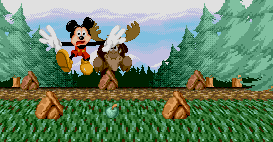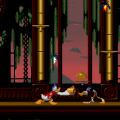Mickey Mouse is one of the most recognizable characters with children worldwide (at least until a certain super plumber hit homes), so it’s no surprise that he’s been a regular go-to and popular license in video games for years. Many big name developing and publishing companies have made well-remembered titles starring the Disney mascot in his own brand-new adventures with both Capcom and Sega creating memories for young gamers across continents. As Mickey’s 65th anniversary drew near, plans to celebrate his birthday with a bash on game systems which unfortunately had to be postponed until next fall: a guided tour of many popular theatrical cartoons starring the lovable mouse himself meeting his earlier selves in the process. At least it wasn’t a half-baked affair like Bugs Bunny’s Birthday Blowout.
This trip down memory lane takes place in 6 cartoons throughout the ages reimagined as side-scrolling platformers. The first level begins with one of the earliest Mickey cartoons, Steamboat Willie, and proceeds in chronological order through such varied locales and thematic setpieces with The Mad Doctor, Moose Hunters, Lonesome Ghosts, Mickey and the Beanstalk (originally packaged as part of the movie Fun and Fancy Free), and with the latest short at the time The Prince and the Pauper. A secret bonus stage is based on The Band Concert where you climb up spinning boxes in the tornado in order to earn a precious extra continue, though fail and you have to reach the bonus stage again.
The gameplay closely resembles that of Sega’s Illusion series of Disney titles, particularly from Castle of Illusion. Mickey’s ways of dealing opposition is the tried-and-true platformer bop from above and from flinging marbles collected in the stage. What sets Mania apart is the more fluid sprite animation thanks in part with the talent of Walt Disney’s own Florida-based animation studio. This smoothness and level of movement puts the graphics on the same level as Virgin Interactive’s Aladdin and Shiny’s Earthworm Jim, essentially “drawing” from the ink-and-paint style Mickey was birthed from. The still young and relatively unknown Traveller’s Tales had just finished with their original IP Puggsy. Mickey Mania became the last game to be released and developed under Sony Imagesoft’s company name before it was merged under SCEA’s management. One famous video game designer got his first credit in this title: future Twisted Metal and God of War creator David Jaffe.
Mickey tackles the game all alone. Aside from Pluto popping up, the only other recognizable faces are the villains or antagonists from the selected cartoons, regardless of whether Donald, Goofy, Minnie, or otherwise played a role. The TV commercial ad stated: “No Goofy. No Minnie. No Mercy” in the standard mid-90s tough guy way. Even the boxart suggests a more badass Mickey in the player’s control than the more awestruck in-game portrayal (much in the way the lovable pink Kirby is marketed in multiple TV ads and game covers, Mickey’s sporting that angry brow in print only). While many of the cartoons used were selected as being varied and open to being “gamified” with obstacles and bosses, many potential choice shorts and onscreen roles were oddly left out, like Thru the Mirror or Brave Little Tailor. This game practically screams for a The Sorcerer’s Apprentice level. Regardless, Mickey must survive in order to save himself — or rather, himselves, in order to set the cartoon worlds right from the influx of the dangers. The weak premise merely serves to string along the loosely tied set of levels with only a few lines of text between the sometimes rather short stages of what and why you’re there in relation to the cartoon’s story, like saving Pluto or merely escaping from the haunted house.
Traveller’s Tales and Sony both pulled some impressive programming trickery to create some rolling scaling 3D effects with sprites not unlike Tower Toppler that serve no ties to the original source material but merely to show off. The Moose Hunters level, while brief, ends with an extended toward-the-screen chase from the mad Alces beast as you leap over rocks and puddles that’d trip you up or slow you down. It’s that added touch that helped differentiate Mickey Mania from the other earlier titles in terms of aesthetics like its fellow season rival Disney’s Magical Quest 2: The Great Circus Mystery Starring Mickey and Minnie by Capcom.
However, as much of the novelty of the use of Disney in-house animation and the seldom-used trek through past appearances, the game itself is a rather average platformer affair. Much of the game is tyical hop-and-bop action done before even in Mickey games by Sega years prior with only some swinging ropes thrown in and rather tedious push-block and switch button puzzles (prepare to push certain objects over multiple screens just to progress). The biggest killer for this game is the hit detection. Mickey tends to get damaged by any foe that invades his personal space rather than merely on his body, which is made worse by his shape squashing and stretching in his jump cycle, leading to his feet grazing threats as he begins to land. Worse yet, everything else from the enemies and pickups seem to disproportionally follow the opposite rules, needing to be in contact juuuuuuust right in order to be hurt or picked up, leading to wasted marbles or frustrating just-out-of-reach items passing through Mickey’s gloved fingers or his ears. Mickey is out of his element dealing with the aerial foes: bats, butterflies, parrots, and dragonflies all wizzing through the sky, hard to shoot down with marbles while hard to pinpoint a boot stomp from above. The Mad Doctor, Beanstalk, and The Prince and the Pauper levels suffer the worst of the cheap hits as they become gauntlets of dodging large enemies and projectiles. The skeletons and weasel enemies serve as the most maddening to face as the former explode into dangerous bone shrapnel upon defeat and the weasels constantly fire knives and arrows from offscreen while only vulnerable to precious marble ammo, and both enemies are legion in their respective stages. Only a slow and pensive mouse can make it through unscathed.
The Genesis/Mega Drive version serves as the cornerstone of all the ports created. The Super Nintendo concurrent release, while sporting a wider color palette, nixs a lot of content and visual flair from the game. The film effect at the start of Steamboat Willie is axed, along with the spiral faux-3D staircase segment in the The Mad Doctor stage and the removal of the Bonus The Band Concert level, along with various minor emitted sprite content the system should be more than capable of producing like Pluto following you inside Lonesome Ghost’s basement. Worse yet, the SNES version has lengthy loading time inbetween levels! The only graphical advantages the SNES contains is a smoother Mode 7-enchanced Moose Chase rolling effect and almost polygonal barrels that roll down on the single stairwell section.
The Sega CD port is exact to the Genesis version with the standard upgrades to the music and audio. Michael Giacchino, a veteran composer for Disney movies and theme park soundtracks, fleshes out the music and adds extra scores into the mix. There are also much more quips from the late talented Wayne Allwine, making many remarks to the level (“These ghosts look lonesome…”, “Mmm, cheese. My favorite!”) and even warns of upcoming threats (“Watch for falling rocks!”, Look out for the bats!” “Fireballs!”, “Skeletons!”, “Weasels!”).
The PlayStation port that arrived in the PAL territories in the spring of 1996 is arguably the best version of Mickey Mania, though it was rebranded under the title Mickey’s Wild Adventure. Every background has been redrawn in a more lush splendor and all the characters’ sprites have been boosted with more color, as well as better transparency filtering. The Sega CD music and voice cues are kept intact and the loading is a little faster thanks to the PlayStation’s 2x spin speed. A few effects like the acid pools and flames are converted to rippling blurred textures. The biggest change, however, lies in the removal of the fake 3D effects in favor of real polygons, so the chase and spiral staircase segments have been radically altered. In fact, a new chase section is added at the end of Mickey and the Beanstalk stage, with our hero being chased by the previously unseen giant from the cartoon. Both chase scenes are expanded to have fences and curves to swerve through rather than just the static straight rolling log effect as well as a helpful bar to show how far you have left until the chase ends. Unfortunately, both sections have severe fog added to help visually show how close the dangerous threat is in relation with Mickey, but it’s almost at Silent Hill / Turok level of pea soup impenetrable wall of cloud. The added hazards do make these sequences even more difficult to further push the Nintendo Hard factor of the game that much higher. In Spring of 2012, Europe and Australia’s PSN store added Mickey’s Wild Adventure to the download service, making it the cheapest and easiest route to obtain and play the game in those regions.
Sony and co. made the effort that they could make a great Mickey game that could stand with the big dogs while giving a guided tour of the mouse’s exploits. While the end product might not hold as the better game compared to Sega or Capcom’s work, it helped jumpstart the careers of fledging companies and designers that’d create much more well-received and recognized franchises and characters than Disney’s very own mouse. The somewhat tongue-in-cheek credits even ask for the gamers to watch the newest upcoming Mickey animated short Runaway Brain. Sadly, said short remains rather forgotten much like the Mickey game that could in contrast to more recent adventures.


